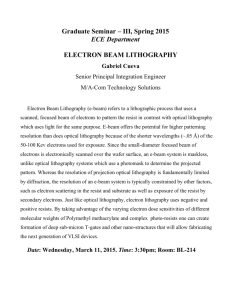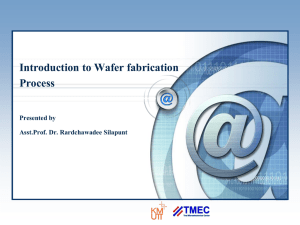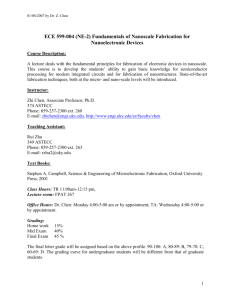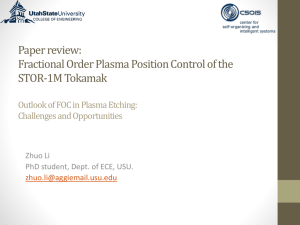JHSEO_APL_Supplementary Materials_2
advertisement
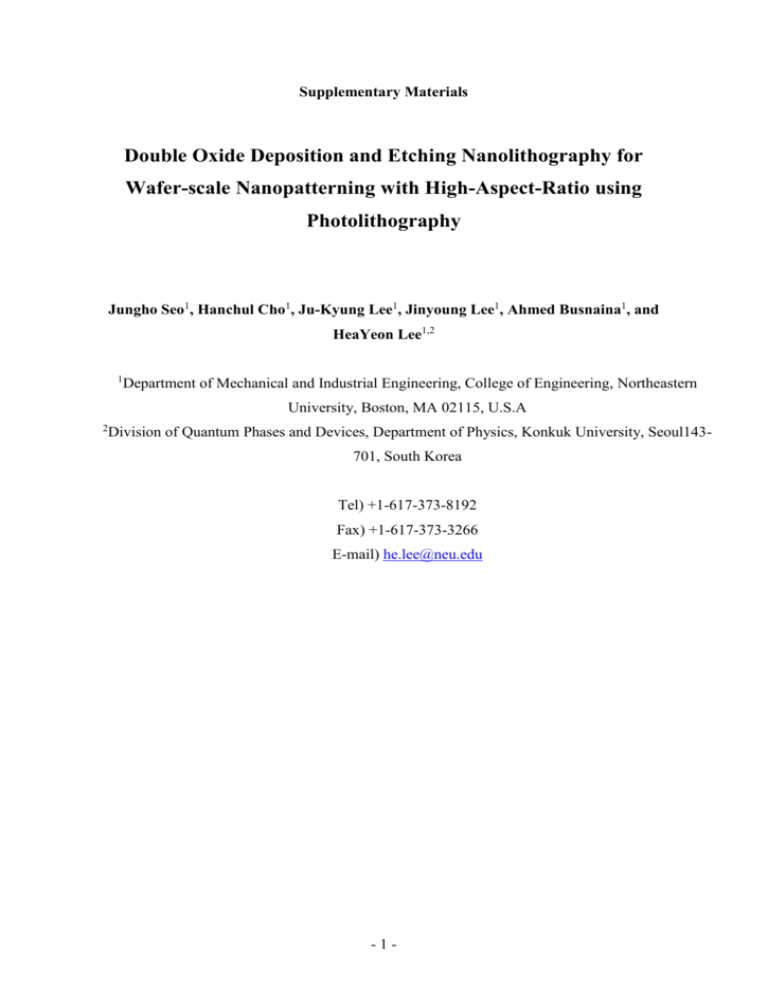
Supplementary Materials Double Oxide Deposition and Etching Nanolithography for Wafer-scale Nanopatterning with High-Aspect-Ratio using Photolithography Jungho Seo1, Hanchul Cho1, Ju-Kyung Lee1, Jinyoung Lee1, Ahmed Busnaina1, and HeaYeon Lee1,2 1 Department of Mechanical and Industrial Engineering, College of Engineering, Northeastern University, Boston, MA 02115, U.S.A 2 Division of Quantum Phases and Devices, Department of Physics, Konkuk University, Seoul143701, South Korea Tel) +1-617-373-8192 Fax) +1-617-373-3266 E-mail) he.lee@neu.edu -1- S1. Anisotropic Plasma Etching Process The DODE lithography method uses plasma etching to avoid isotropic wet etching. The anisotropy of the etching can be modulated through adjustment of the parameters of the plasma to deliver the plasma radicals vertically onto the surface. The mean free path of the plasma radicals can be modified by the plasma etching conditions.1-3 A low mean free path produces an isotropic etching profile with a lateral etch rate that is approximately equal to the downward etch rate. Therefore, optimized etching conditions are an important factor in obtaining high-mean-free-path plasma radicals for etching the nanotrench. We investigated the relationship between the nanosize of the pattern and the plasma etching conditions by varying the pressure, gas flow rate, and RF power. Our ICP system consists of platen bias which is applied to parallel plate and coil bias for a high-density plasma source of ions. We defined the anisotropy by following formula: A 1 RL RV where, A is anisotropy, RL is lateral etch rate, and RV is vertical etch rate. 1. Effect of Pressure The effect of pressure was investigated, as shown in Fig. S1. The aspect ratio and etch rate decreased as the process pressure was increased (Fig. S1a). The other plasma etching conditions were held constant as follows: platen power (250 W), coil power (350 W), O2 gas flow rate (0 sccm), SF6 gas flow rate (6 sccm), Ar gas flow rate (4 sccm), and 5 min of etching time. The process was studied at pressures of 5 mTorr (Fig. S1b), 10 mTorr (Fig. S1c), and 15 mTorr (Fig. S1d). Pressure is an important factor in determining the direction of motion of the plasma radicals.4 The mean free path depends on the pressure. The collision probability is proportional to the pressure, so that the radicals collide with the sidewalls at high pressures. Thus, a low-pressure plasma is suited to vertical anisotropic etching. -2- FIG. S1. Effect of pressure on plasma anisotropic etching: (a) 5 mTorr, (b) 10 mTorr, and (c) 15 mTorr . 2. Effect of the Oxygen Gas Flow Rate The nanoscale SiO2 trench was etched using SF6/Ar/O2 gas mixtures in an ICP system. The effect of the O2 gas flow rate was studied using different flow rates of 0 sccm (Fig. S2b), 2 sccm (Fig. S2c), and 4 sccm (Fig. S2d) with a fixed SF6 (6 sccm) + Ar (4 sccm) flow rate. An increase in the O2 gas flow rate decreased the SiO2 etch rate and the anisotropic etch ratio, as shown in Fig. S2a. A SF6-based gas mixture is typically used to etch SiO2, where sidewall etching is prevented by the deposition of a fluorocarbon polymer on the sidewall. The O2 gas plays role to decompose the deposition of the fluorocarbon polymer, which decreases the anisotropic etch ratio.5 The etch profile is difficult to maintain as the size of the trench is reduced to the nanoscale. Thus, a fluorocarbon gas is needed for an anisotropic etch profile. -3- FIG. S2. Effect of O2 gas flow rate on plasma anisotropic etching: (a) 0 sccm, (b) 2 sccm, and (c) 4 sccm. 3. Effect of RF Power An increase in the platen power increased both the SiO2 etch rate and the anisotropic etch ratio linearly (Fig. S3a). The platen power tests corresponded to 150 W (Fig. S3b), 250 W (Fig. S3c), and 350 W (Fig. S3d) at a coil power of 350 W and with a gas mixture of SF6 (6 sccm) / Ar (4 sccm). The gas flow rates were held fixed while a pressure of 5 mTorr was maintained. A vertical etching profile is related to the direction of motion of incident radicals, which can be implemented by the anisotropic motion of ions.6 The platen power was applied to the substrate plate to create directional electric fields near the substrate to heighten the anisotropy of the etching profile. The anisotropic etching profile was obtained when the incident ions were delivered over a small angle into the nanotrench through an increase in the platen power. -4- FIG. S3. Effect of platne power on plasma anisotropic etching: (a) 150 W, (b) 250 W, and (c) 350 W. S2. DODE (Double Oxide Deposition and Etching) Lithography Process Fig. S4a shows the changes in the linewidth of microstructure due to the deposition of the 2nd SiO2 layer. The 1.5-μm-thick second SiO2 layer was deposited onto the 500-nm-thick first SiO2 layer of the microstructure. The 725-nm-thick oxide was deposited laterally on both sides of the sidewall to obtain a 50-nm nanopattern. Moreover, 1 μm of residual SiO2 remained on the bottom of the nanopattern. The residual SiO2 was removed by anisotropic dry etching, as shown in Fig. S4b. Consequently, SiO2-based nanostructures were successfully fabricated with high aspect ratios that were greater than 20:1. -5- FIG. S4. DODE lithography process for high-aspect-ratio nanostructure fabrication: (a) after oxide deposition on the microstructure and (b) after dry etching of the residual SiO2. S3. Nanolithography on 3-inch Au Wafe Substrate DODE lithography method can be applied to different substrates such as glass, plastic and metal. Fig. S5 shows the nanopatterning on 3-inch Au wafer by DODE process. FIG. S5. Nanopatterning on a 3-inch Au wafer by DODE lithography. Various patterns of microstrucrues were transferred from photomask through photolighography process. And nanopatterns were obtained by DODE process . S4. Time Cost Comparison of DODE nanolithography with E-beam Lithography The electron beam lithography is a commercialized lithography process for nano-scale patterning. However, the key disadvantage of this method is low-throughput due to its low-speed process time. The process time of the e-beam lithography is proportional to exposure area and is given by the following formula:7 -6- T D A I where T is the process time, I is the beam current, D is the dose and A is the exposed area. Therefore, the e-beam lithography is not suitable for high-volume manufacturing. Meanwhile, the DODE lithography is not proportional to exposure area but process steps because the nanopatterns were created from micropatterns which were transferred from mask through optical photolithography process. The optical lithography is much faster than e-beam lithography for micron-size patterning for wafer-scale manufacturing. The DODE lithography process has additional thin film deposition and etching processes for nanoscale patterning as shown in Fig. S6a. The approximate process time for nanopatterning on a Si wafer is about 1 hour. In our e-beam lithography system, the beam current is 38.7 pA for 10 μm aperture size and the area dose amount is 524.8 μC/cm2. So the exposure area of the e-beam system is about 265.5 μcm2 during the 1 hour of writing time. To cover the 175 cm2 surface area of a 75 mm of Si wafer, the minimum process time would extend to 2 × 109 s, about 75 years. Consequently, high-throughput manufacturing is possible for DODE lithography method in terms of wafer-scale lithography because it is scalable and batch process is possible as shown in Fig. S6b. Moreover, the e-beam lithography is not compatible with plasma etching process for high aspect-ratio nanostructure manufacturing because the e-beam resists are very thin layer. Therefore, the DODE technique is promising lithography for large-scale and high-aspect ratio nanostructure fabrication. FIG. S6. Comparison of DODE lithography with e-beam lithography for time cost of process: (a) process steps of DODE and e-beam lithography for SiO2 nanopatterning on Si wafer and (b) process time as a function of exposure are. -7- 1 M. J. Kushner, J. Appl. Phys. 53, 2939 (1982). 2 D. L. Flamm, V. M. Donnelly and D. E. Ibbotson, J. Vac. Sci. Technol. B 1, 23 (1983). 3 S. Samukawa, Jpn. J. Appl. Phys. 33, 2133 (1994). 4 M. Tuda, K. Nishikawa and K. Ono, J. Appl. Phys. 81, 960 (1997). 5 C. J. Mogab, A. C. Adams and D. L. Flamm, J. Appl. Phys. 49, 3796 (1978). 6 R. J. Shul, G. B. McClellan, S. A. Casalnuovo, D. J. Rieger, S. J. Pearton, C. Constantine, C. Barratt, R. F. Karlicek, C. Tran and M. Schurman, Appl. Phys. Lett. 69, 1119 (1996). 7 N. W. Parker, A. D. Brodie and J. H. McCoy, Proc. SPIE 3997, 713 (2000). -8-


